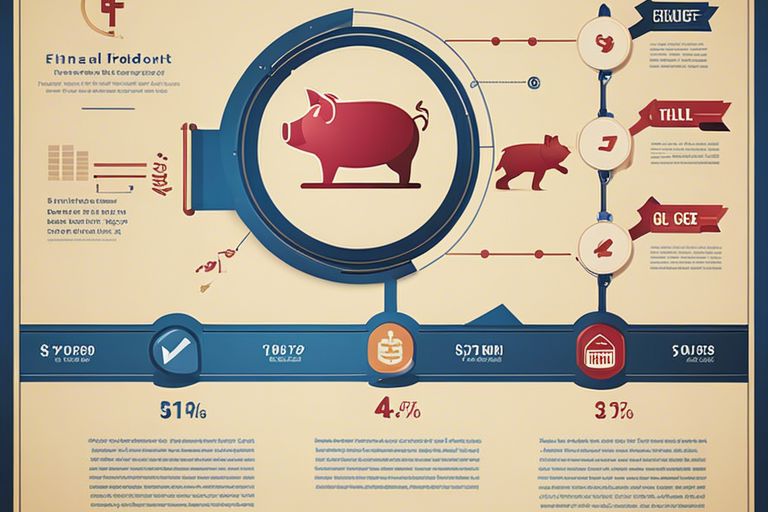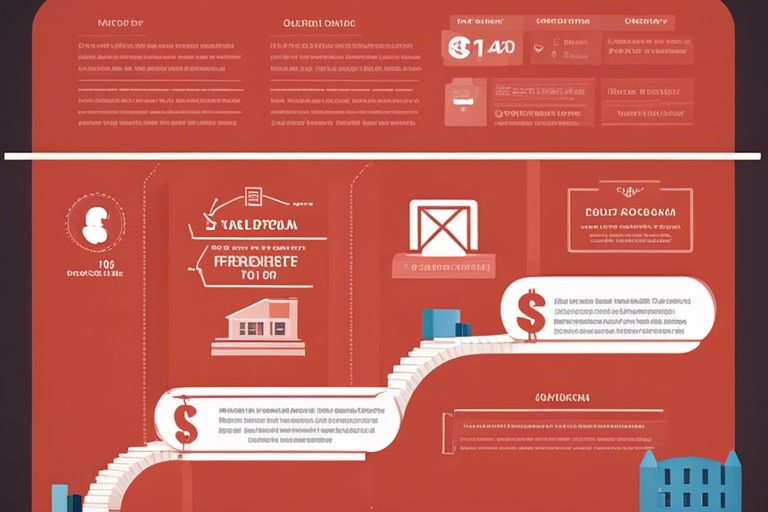Designing a personalized blueprint for achieving financial freedom is a crucial step towards creating the ideal lifestyle you desire. It requires careful planning, goal setting, and a commitment to making smart financial decisions. In this comprehensive guide, we will walk you through a step-by-step process to help you outline your path to financial independence and design a life that aligns with your goals and values.
Key Takeaways:
- Set clear financial goals: Begin by defining your long-term financial goals, including how much money you need to achieve financial freedom and lead your ideal lifestyle. Be specific and realistic in your goal-setting.
- Create a detailed financial plan: Develop a personalized plan that outlines your income sources, expenses, savings, investments, and debt repayment strategy. Ensure your plan is flexible and can adapt to changing circumstances.
- Focus on increasing income: Look for opportunities to increase your income through salary raises, side hustles, investments, or starting a business. Diversifying your income streams can help you achieve financial independence faster.
- Eliminate debt and build savings: Prioritize paying off high-interest debts and create an emergency fund to cover unexpected expenses. Building a solid financial foundation is important for achieving financial freedom.
- Monitor and adjust your financial plan: Regularly review your progress towards your financial goals, track your expenses, and adjust your plan as needed. Consistent monitoring allows you to stay on track and make informed decisions about your financial future.
Assessing Your Current Financial Situation
One of the first steps in creating a personalized blueprint for financial freedom is assessing your current financial situation. This involves taking a close look at your income, expenses, assets, and liabilities to gain a clear understanding of where you stand financially.
How to Analyze Your Income and Expenses
The key to mastering your finances is understanding how your money flows in and out each month. Start by tracking all sources of income, including salary, bonuses, investment returns, and any other earnings. Next, analyze your expenses by categorizing them into fixed expenses (such as rent or mortgage payments) and variable expenses (such as dining out or shopping). This will help you identify areas where you can potentially cut back and save more.
Identifying Financial Strengths and Weaknesses
Your financial strengths are areas where you excel, such as having a high income or a strong savings discipline. On the other hand, weaknesses may include high levels of debt or overspending habits. By identifying these strengths and weaknesses, you can develop a strategy to build on your strengths and address any weaknesses to improve your overall financial health.
Understanding your financial situation is the foundation for creating a roadmap to financial freedom. By conducting a thorough analysis of your income, expenses, assets, and liabilities, you can gain valuable insights that will guide your path towards achieving your financial goals.
Exploring the Types of Financial Freedom
Assuming you are ready to launch on the journey towards financial freedom, it’s crucial to understand the various types of financial freedom that exist. Recognizing the different paths to financial independence will help you create a personalized blueprint tailored to your goals and lifestyle.
| Types of Financial Freedom | Description |
|---|---|
| Time Freedom and Passive Income |
Time Freedom and Passive IncomeTime freedom allows you to have control over how you spend your time, rather than being tied to a traditional work schedule. Passive income streams are sources of income that require minimal effort to maintain, providing you with the flexibility to pursue other interests and passions. |
| Financial Independence Retire Early (FIRE) |
Financial Independence Retire Early (FIRE)Financial Independence Retire Early (FIRE) is a movement focused on achieving financial independence at a young age, typically in your 30s or 40s. By saving a large percentage of your income and investing wisely, you can build a sizable nest egg that allows you to retire early and live off your investments. |
| Debt Freedom and its Impact |
Debt Freedom and its ImpactDebt freedom is the state of being debt-free, without any outstanding loans or financial obligations. Achieving debt freedom can significantly reduce financial stress and provide more opportunities for saving and investing for your future. |
Time freedom and passive income are key components of designing a blueprint for financial freedom. By generating passive income streams and prioritizing how you spend your time, you can create a lifestyle that aligns with your values and goals. Likewise, the FIRE movement offers a roadmap for early retirement and financial independence, emphasizing the importance of saving and investing for the future.
Debt freedom plays a crucial role in achieving financial freedom by eliminating the burden of debt and freeing up more resources for saving and investing. By prioritizing debt repayment and managing your finances effectively, you can accelerate your journey towards financial independence and create a more secure financial future.

Setting Clear Financial Goals
Now, before you launch on your journey towards financial freedom, it is crucial to set clear and achievable financial goals. These goals will serve as the roadmap to guide your financial decisions and actions.
Short-Term vs. Long-Term Goals
Some financial goals are short-term in nature, focusing on immediate needs and priorities like paying off debt or building an emergency fund. On the other hand, long-term goals encompass larger milestones such as saving for retirement or purchasing a home. It is imperative to strike a balance between short-term and long-term goals to ensure financial stability and growth over time.
The Role of SMART Goals in Financial Planning
Goals that are Specific, Measurable, Achievable, Relevant, and Time-bound (SMART) are integral to effective financial planning. By creating SMART goals, you can clearly define your objectives, track your progress, and stay motivated towards achieving financial success. Whether it’s saving a specific amount each month or increasing your income by a certain percentage, SMART goals provide a framework for your financial journey.
Creating a Step-by-Step Plan
Many individuals dream of achieving financial freedom and designing their ideal lifestyle, but often struggle with where to start. To guide you on this journey, consider utilizing the Financial Freedom Blueprint: A Step-by-Step Guide to help you create a personalized blueprint for success.
The Budgeting Process
Now, let’s investigate the first step of designing your financial freedom blueprint – the budgeting process. This crucial step involves assessing your current financial standing, setting financial goals, tracking your expenses, and creating a budget that aligns with your long-term objectives.
To effectively budget, start by calculating your monthly income and expenses. Differentiate between necessary expenses like housing, utilities, and groceries, and discretionary spending like dining out and entertainment. This breakdown will help you identify areas where you can cut back and save more effectively.
Saving Strategies and Building Emergency Funds
Saving is a fundamental aspect of achieving financial freedom. By prioritizing saving strategies and building an emergency fund, you can provide yourself with a safety net for unexpected expenses and work towards your long-term financial goals.
To start saving effectively, set specific savings goals and automate your savings by setting up automatic transfers to a separate savings account. Additionally, consider cutting back on non-necessary expenses and finding ways to increase your income to bolster your savings efforts.
To dive deeper into saving strategies and building emergency funds, consider allocating a portion of your income towards an emergency fund that can cover three to six months’ worth of living expenses. This fund will provide you with financial security in case of unforeseen circumstances like job loss or medical emergencies.
Investment Options and Their Risk Factors
Little by little, you can grow your wealth through strategic investments. Understanding investment options and their associated risk factors is crucial in building a diversified investment portfolio that aligns with your financial goals and risk tolerance.
- Stocks: Investing in stocks can provide potentially high returns but also come with higher risks due to market volatility. It is necessary to conduct thorough research and diversify your stock investments to mitigate risks.
- Bonds: Bonds are considered safer investments than stocks and offer steady interest income. However, they come with lower potential returns. Consider diversifying your portfolio with a mix of stocks and bonds for a balanced investment strategy.
Their risk factors must be carefully evaluated to ensure they align with your financial goals and risk tolerance. Through a combination of budgeting, saving strategies, and smart investment decisions, you can pave the way towards financial freedom and design the lifestyle you desire. Start creating your personalized blueprint today!
Tips for Managing and Reducing Debt
Unlike other financial goals, managing and reducing debt should be a top priority when creating your financial freedom blueprint. Debt can hinder your progress towards financial independence and limit your ability to design your ideal lifestyle. Here are some tips to help you effectively manage and reduce your debt:
- Create a budget and stick to it to ensure you have a clear understanding of your financial situation.
- Focus on paying off high-interest debts first to minimize interest payments and save money in the long run.
- Consider negotiating with creditors for lower interest rates or more favorable repayment terms.
- Avoid taking on new debt while working towards reducing your current debt load.
Efficient Debt Repayment Methods
Any debt repayment method you choose should be tailored to your financial situation and goals. Some popular debt repayment methods include the snowball method, where you pay off debts from smallest to largest, and the avalanche method, where you tackle debts with the highest interest rates first.
Understanding the Pros and Cons of Consolidation
While debt consolidation can be a useful tool for simplifying your debt repayment process, it’s imperative to weigh the pros and cons before deciding to consolidate your debts. For instance, consolidating your debts into a single loan can lower your monthly payments and streamline your finances. However, it may also result in a longer repayment period and higher overall interest costs.
After carefully considering the advantages and disadvantages of debt consolidation, you can make an informed decision that aligns with your financial goals and helps you achieve financial freedom.

Income Growth and Diversification
All individuals striving for financial freedom must continually explore avenues for income growth and diversification. One important resource to aid in this pursuit is the book, Financial Freedom Blueprint: A Step-by-Step Guide to Wealth by Nicki Robin, which offers invaluable insights and actionable strategies to enhance your financial journey.
Exploring Side Hustles and Passive Income Streams
Income diversification is key to achieving financial stability and freedom. Exploring side hustles and cultivating passive income streams can significantly boost your earnings potential. Whether through freelance work, rental properties, investments, or online businesses, these supplementary income sources can provide a steady stream of revenue that builds over time without requiring constant active involvement.
Advantages and Considerations in Starting a Business
Starting a business can be a powerful vehicle for income growth and wealth accumulation. As an entrepreneur, you have the potential to control your financial destiny, create multiple income streams, and build assets with significant value. However, launching a business also entails risks and challenges that require careful consideration and strategic planning to mitigate potential pitfalls.
You must assess your strengths, skills, and passions to determine the most suitable business venture for you. Conduct thorough market research, develop a solid business plan, and seek guidance from mentors or industry experts to maximize your chances of success in the entrepreneurial realm.
Continuously Tracking and Adapting Your Plan
Keep a close eye on the progress of your financial freedom blueprint by regularly reviewing your key financial ratios and performance indicators. For more detailed insights on this topic, refer to Wealth Blueprint: Building Financial Freedom ….
Key Financial Ratios and Performance Indicators
Any successful financial plan relies on monitoring key financial ratios and performance indicators. These metrics will give you a clear picture of your financial health and help you make informed decisions on where adjustments may be necessary.
How to Adjust Your Plan for Life Changes
Any significant life changes such as job transitions, marriage, starting a family, or unexpected expenses should prompt a review and adjustment of your financial freedom blueprint. It’s crucial to adapt your plan to accommodate these changes and ensure you stay on track towards achieving your desired lifestyle.
Adapting your financial plan requires a proactive approach and flexibility in making necessary changes to align with your current circumstances. Regularly reassessing your goals, expenses, income, and investment strategies will help you maintain a sustainable financial roadmap towards achieving your ideal lifestyle and long-term financial freedom.
Protecting Your Financial Freedom
Not taking the necessary steps to protect your financial freedom can leave you vulnerable to unexpected events that can derail your progress. One crucial aspect of safeguarding your financial well-being is through insurance and risk management strategies.
Insurance and Risk Management Strategies
Assuming that unforeseen circumstances such as illness, accidents, or natural disasters could impact your finances, having the right insurance coverage is necessary. Health insurance can help cover medical expenses, while disability insurance can provide income if you are unable to work. Additionally, property insurance safeguards your assets against damage or loss, and life insurance offers financial protection for your loved ones in the event of your passing.
Estate Planning and Preserving Wealth for Future Generations
Your financial freedom blueprint should also include estate planning to ensure that your wealth is preserved and passed down to future generations according to your wishes. Estate planning involves creating a will, establishing trusts, and designating beneficiaries for your assets. It allows you to minimize estate taxes, avoid probate, and provide clear guidance on how your assets should be distributed.
Wealth transfer is a critical component of estate planning, and it can influence the financial security of your heirs and beneficiaries for generations to come. Properly managing your estate not only protects your wealth but also allows you to leave a lasting legacy that aligns with your values and goals.

Conclusion
Considering all points discussed in this comprehensive guide, creating a personalized blueprint for achieving financial freedom and designing your ideal lifestyle is an achievable goal with proper planning and execution. By setting clear financial goals, creating a budget, paying off debt, investing wisely, and diversifying income streams, you can pave the path towards financial independence.
Remember that designing your ideal lifestyle goes beyond just material wealth – it involves aligning your finances with your values and priorities, and creating a life that brings fulfillment and happiness. By following the steps outlined in this guide and staying committed to your financial goals, you can work towards creating a life of abundance, freedom, and prosperity. Take charge of your financial future today and start building the blueprint for the life you truly desire.




